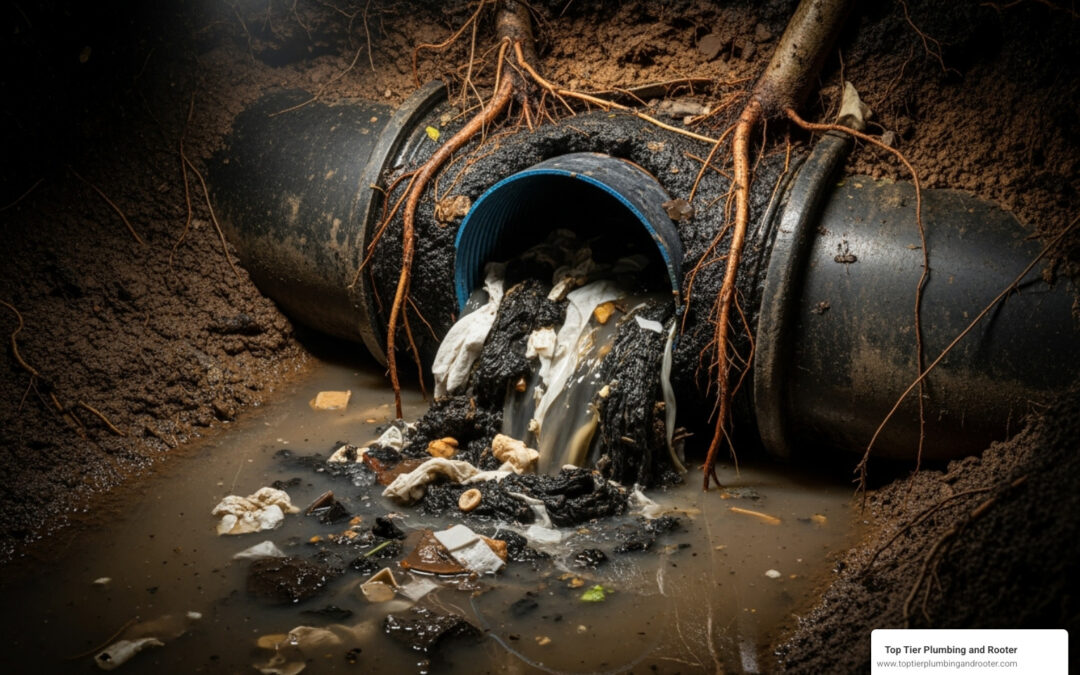Why Main Sewer Line Clogs Are a Serious Plumbing Emergency
A main sewer line clog is one of the most serious plumbing problems a homeowner can face. When the primary pipe that carries all wastewater from your home becomes blocked, it affects every drain, toilet, and fixture in your house, creating a plumbing emergency.
Quick Action Guide for Main Sewer Line Clogs:
- Stop using all water – No flushing toilets, running sinks, or washing machines.
- Check for warning signs – Multiple drains backing up, gurgling sounds, sewage odors.
- Locate your sewer clean-out – Usually found in your yard or basement.
- Call a professional immediately – DIY methods often make the problem worse.
- Don’t use chemical drain cleaners – They can damage pipes and create toxic fumes.
Your main sewer line is the primary artery of your home’s plumbing system. All smaller drain pipes from sinks, toilets, and showers feed into it. When this main line gets blocked, wastewater has nowhere to go and backs up into your home, often through the lowest drains first.
Unlike a simple clog affecting one fixture, a main sewer line blockage can cause raw sewage to back up into your home, creating serious health hazards and water damage. The longer you wait, the worse the problem becomes.
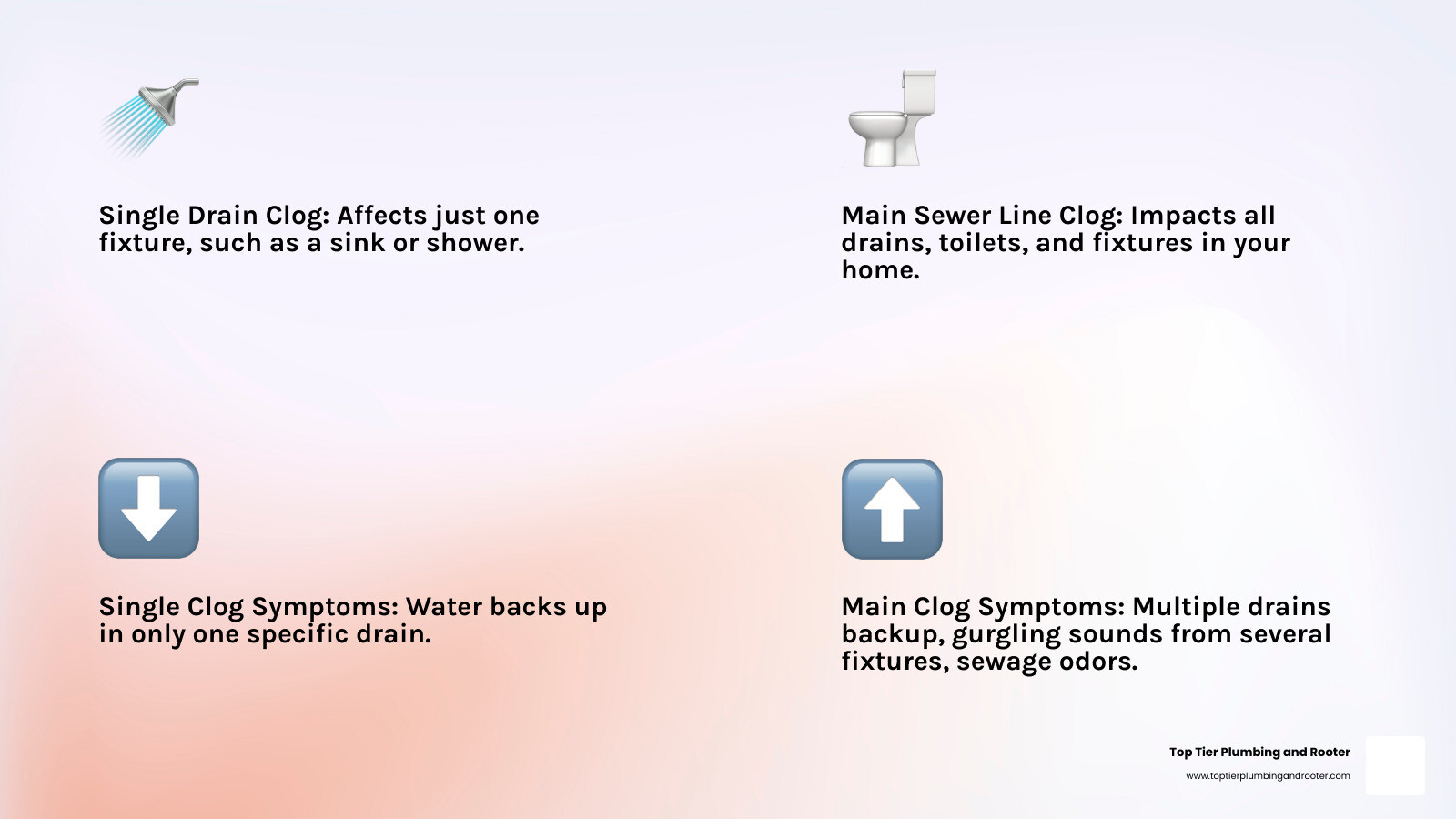
How to Tell If You Have a Clog: Key Warning Signs
Knowing whether you have a simple drain clog or a main sewer line clog is crucial. A single clogged sink is an annoyance; a blocked main line is an emergency that can affect your entire home.
Multiple drains backing up is the biggest red flag. If you flush a toilet and water bubbles up in the shower, or running the washing machine causes toilets to gurgle, you likely have a main line problem. The wastewater has nowhere to go and is being forced back up through other drains.
Other key signs include:
- Gurgling sounds from multiple drains and toilets. This is the sound of trapped air being displaced by water that can’t flow freely.
- Foul sewage odors in your home, especially in the basement. This indicates that sewer gases are backing up through your drains.
- Slow drains throughout the house. When every drain starts draining slowly, your main line is struggling to handle the flow.
- Floor drain backups in basements or laundry rooms. Since these are the lowest points in your home’s plumbing, a backup here signals a severe blockage.
| Feature | Single Drain Clog | Main Sewer Line Clog |
|---|---|---|
| Affected Areas | Just one fixture | Multiple drains throughout the house |
| Water Backup | Only where the clog exists | Water appears in other fixtures when you use one |
| Sounds | Maybe some local gurgling | Gurgling from multiple locations |
| Odors | Usually none | Strong sewage smell |
| Urgency Level | Annoying but manageable | Emergency requiring immediate action |
Ignoring these warning signs can lead to the hidden dangers of ignoring drainage issues: What homeowners need to know.
Checking Your Sewer Clean-Out Pipe
Your sewer clean-out is a capped pipe that provides direct access to your main sewer line. It’s a key diagnostic tool.
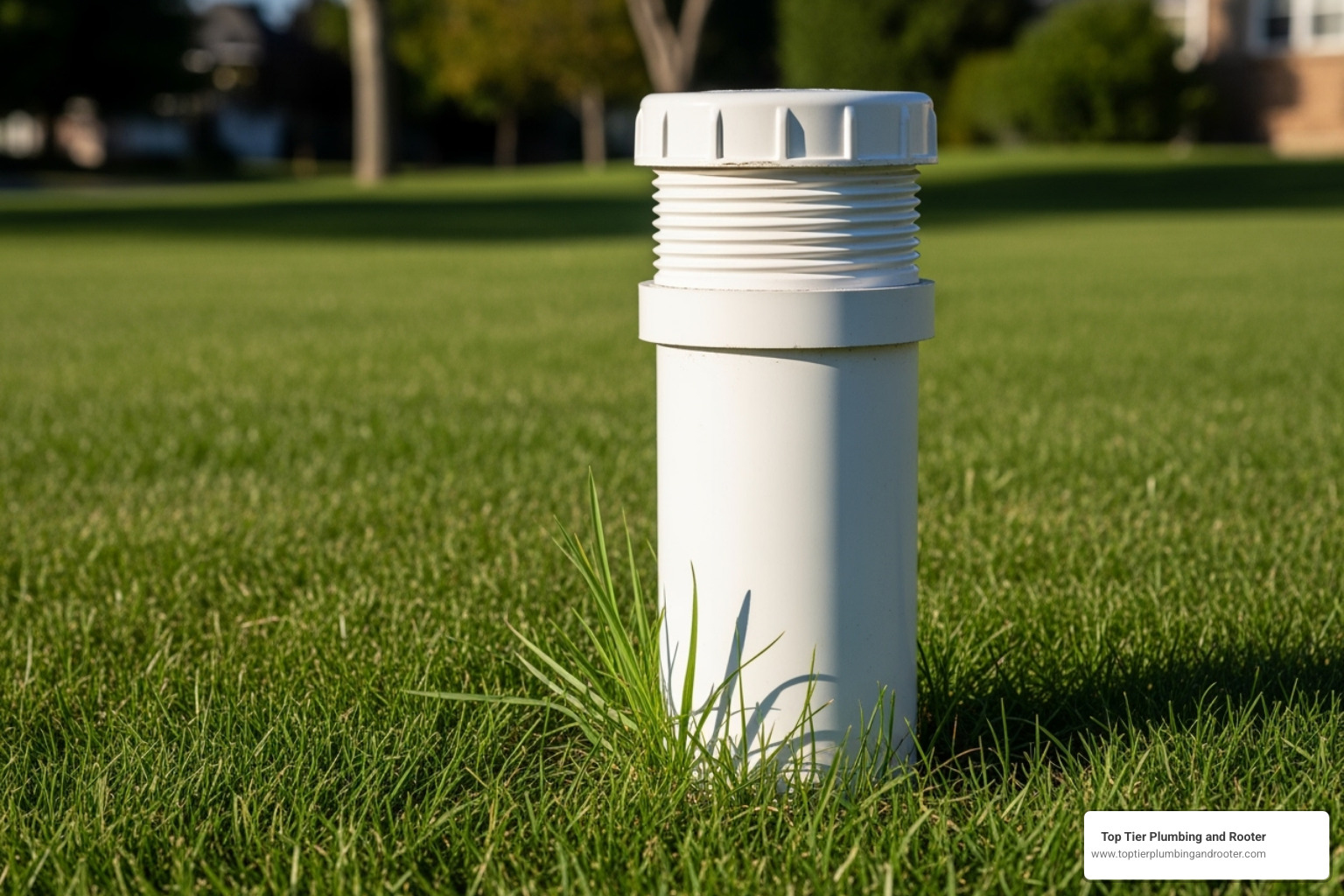
- Locate the clean-out: Look for a 3- to 4-inch capped pipe near your foundation, in the yard, basement, or crawl space.
- Remove the cap safely: There may be pressure built up. Wear gloves and remove the cap slowly. If you are not comfortable, leave this step to a professional.
- Observe the pipe: If you see standing water or sewage flowing out, you have confirmed a main sewer line clog between the clean-out and the city sewer. If the pipe is clear, the clog is likely inside your home’s plumbing.
If you find standing water or sewage at the clean-out, call a professional immediately. This is not a DIY situation and requires expert tools and experience.
Understanding the Causes of a Main Sewer Line Clog
Main sewer line clogs rarely appear overnight. They are typically the result of gradual buildup or structural problems. Understanding the causes can help you prevent future issues. For more details, explore why do I have a clogged sewer line?.
Common structural causes include:
- Pipe Damage: Older pipes made of clay or cast iron are vulnerable to cracking or collapsing from shifting soil and other external pressures.
- Sagging Sewer Lines: Sections of pipe can sink over time due to poor installation or unstable ground, creating low spots or “bellies” where waste and debris collect.
- Buildup Over Time: Years of soap scum, mineral deposits, and other residue can coat the inside of pipes, narrowing the diameter and catching debris.
Tree Root Intrusion
Tree roots are a primary cause of main sewer line clog emergencies, especially in areas with mature trees.
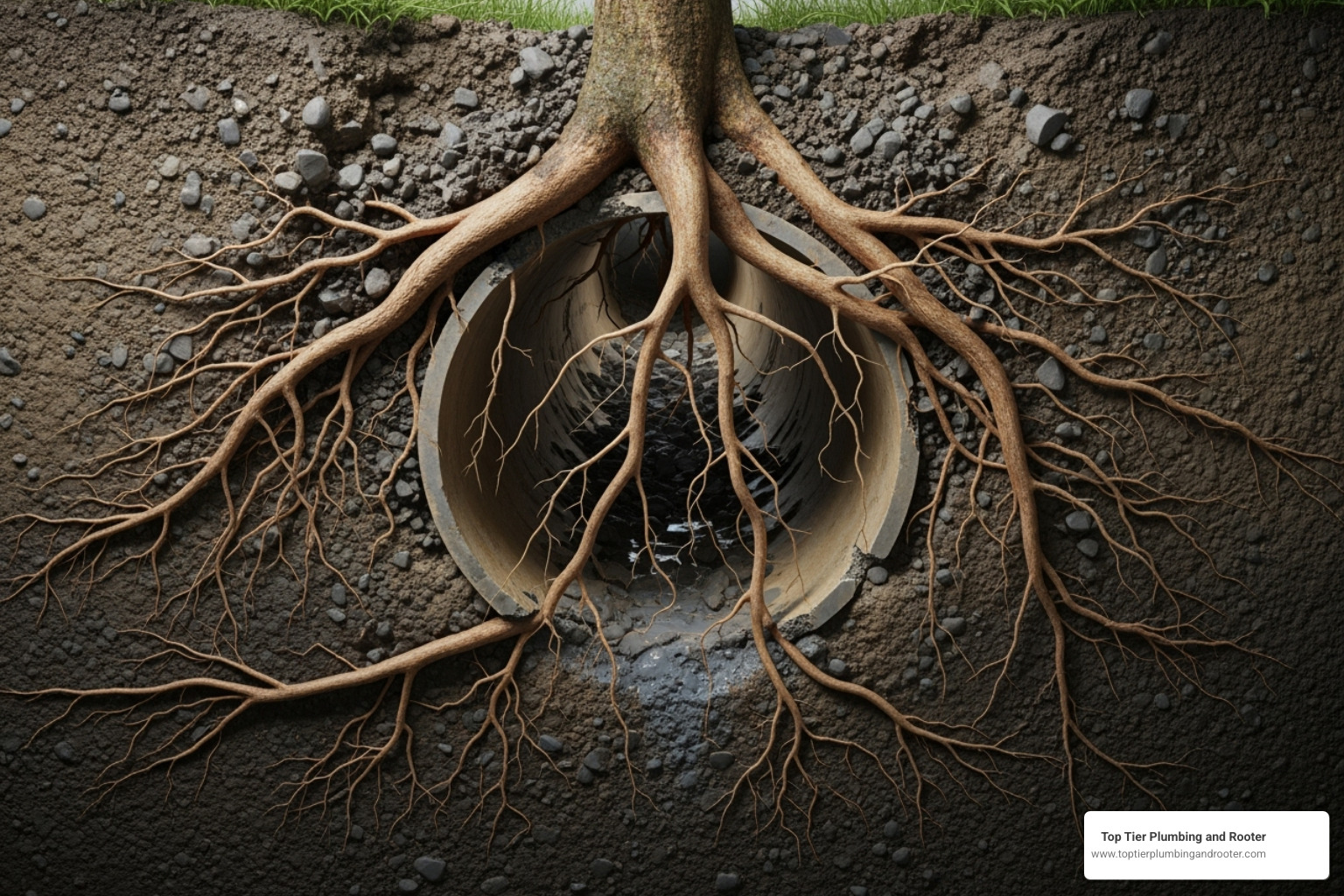
Roots are naturally drawn to the moisture and nutrients in your sewer line. They can detect vapor escaping from tiny cracks or loose joints in pipes. Older pipe materials like clay and cast iron are especially susceptible. Once roots find an entry point, they expand inside the pipe, creating a dense mass that traps waste and debris. This pressure can turn small cracks into major breaks, eventually leading to a complete blockage.
Grease, Fats, and Improperly Flushed Items
Many stubborn main sewer line clogs are caused by items that should never enter the drainage system.
- Grease Solidification: When hot cooking grease, oil, or fat is poured down the drain, it cools and solidifies into a waxy coating on pipe walls. This buildup narrows the pipe and traps other debris.
- Improperly Flushed Items: So-called “flushable” wipes do not break down like toilet paper. They tangle with other items and form massive clogs. Paper towels, feminine hygiene products, dental floss, and cotton swabs also belong in the trash, not the toilet.
- Food Waste: Even with a garbage disposal, large amounts of food waste can contribute to blockages, especially when mixed with grease.
Changing household habits is key to prevention. For more tips, see the best ways to prevent clogged drains in your kitchen and bathroom.
What to Do: Immediate Steps and Professional Solutions
When you suspect a main sewer line clog, you must act fast to protect your home from a messy and expensive disaster.
First, stop using all water immediately. Do not flush toilets, run faucets, or use appliances like washing machines or dishwashers. Every drop of water sent down the drain will only worsen the backup. If water is already backing up, turn off your home’s main water supply as a precaution. You can usually find the shutoff valve near your water meter or where the main line enters your house.
A main line clog is a true plumbing emergency. For more guidance, see our guide on sewer clearing emergency: How to identify and address urgent sewage issues.
The health and safety risks are significant. Raw sewage contains harmful bacteria (like E. coli), viruses, and parasites. Sewer gases like hydrogen sulfide can also be toxic. Sewage backups can destroy flooring and walls and lead to hazardous mold growth.
DIY Steps and Their Limitations
While the urge to fix it yourself is strong, a main sewer line clog is beyond the scope of most household tools. DIY attempts often make the problem worse.
- Chemical Drain Cleaners: These are ineffective against deep or severe clogs caused by roots or grease. They are also corrosive and can damage your pipes, creating a more dangerous situation for the professional who ultimately has to fix it. Learn more about why you should avoid commercial drain cleaners.
- Plungers: A plunger lacks the power to clear a blockage located far down the main sewer line.
- Hand Snakes: Consumer-grade augers are too short and weak for main line clogs. They may poke a temporary hole but won’t solve the underlying problem and can get stuck in the pipe.
When to Call for Professional Drain and Sewer Repair
If you have persistent clogs, multiple fixtures backing up, or any sewage backup, it’s time to call a professional. We have the specialized equipment to diagnose and resolve these issues safely.
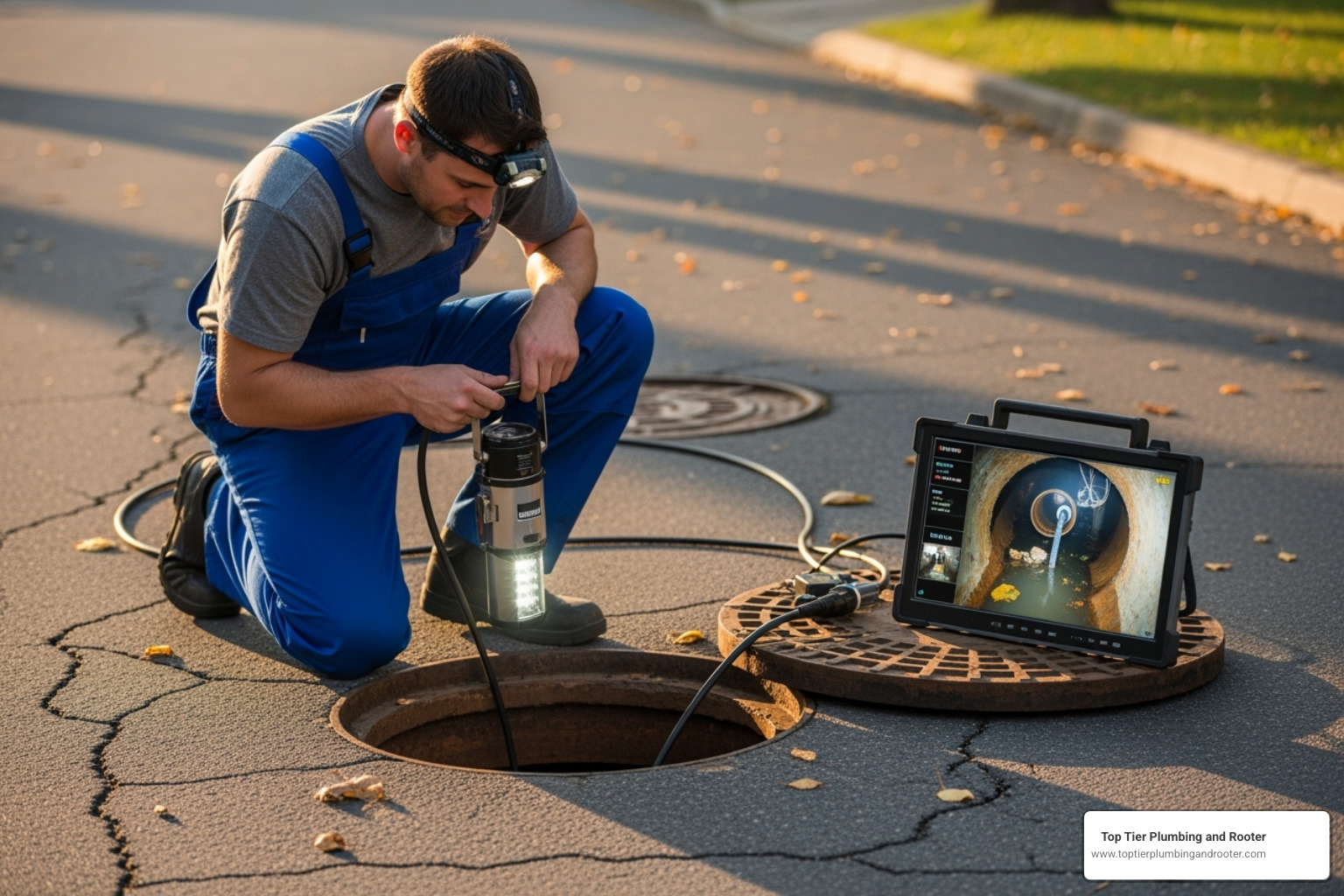
Our professional solutions include:
- Video Camera Inspection: We insert a high-resolution camera into your sewer line to see the exact cause and location of the clog. This eliminates guesswork and is a key part of the role of video inspection in sewer and drain repair.
- Hydro-Jetting: This process uses high-pressure water jets (up to 4,000 PSI) to blast away tough blockages like tree roots and grease buildup, cleaning the entire pipe diameter.
- Trenchless Sewer Repair: For damaged pipes, we offer modern drain cleaning/sewer drain repair solutions. Trenchless methods can repair or replace your sewer line with minimal disruption to your yard, saving time and preserving your landscaping. Find the benefits of trenchless sewer repair for your home or business.
How to Prevent Future Main Sewer Line Clogs
Dealing with a main sewer line clog once is enough. Fortunately, most sewer line problems are preventable with mindful habits and regular maintenance. As noted by the Insurance Information Institute, consistent upkeep is the best way to avoid sewer backups.
Prevention comes down to three key areas: proper waste disposal, using drain strainers, and scheduling regular professional maintenance. For local homeowners, understanding the importance of regular drain cleaning in Riverside and San Bernardino County homes is crucial.
Best Practices for Your Kitchen and Bathroom
Your daily habits have the biggest impact on preventing a main sewer line clog. Your drains are not a substitute for a trash can.
- In the Kitchen: Never pour grease, fats, or oils down the drain. Pour cooled grease into a disposable container and throw it in the trash. Scrape food scraps from plates into the garbage before washing, even if you have a garbage disposal.
- In the Bathroom: The only things that should be flushed are human waste and toilet paper. So-called “flushable” wipes do not break down and are a primary cause of clogs. Never flush paper towels, cotton balls, feminine hygiene products, or other non-dissolvable items.
For a complete guide on keeping your drains clear, check out our tips on drain clog prevention and cleaning.
The Role of Regular Inspections and Maintenance
While good habits are essential, professional maintenance provides long-term protection for your plumbing system.
- Annual Video Inspections: A yearly camera inspection allows us to spot potential problems like small root intrusions, buildup, or early pipe damage before they become emergencies. This is especially important for homes over 20 years old or properties with large trees.
- Preventive Hydro-Jetting: Even without an active clog, hydro-jetting is a powerful maintenance tool. It scours the inside of your pipes, removing years of accumulated grease, soap scum, and mineral deposits to keep your system flowing at full capacity.
Proactive care can save you money and stress. Learn more about the benefits of professional drain cleaning services in Riverside and San Bernardino County.
Frequently Asked Questions about Sewer Lines
Homeowners often have questions about sewer line problems. Here are clear answers to some of the most common ones.
What’s the difference between a problem with my sewer line and the city’s main?
Understanding responsibility is key. The homeowner is responsible for the private sewer lateral, which is the pipe running from the house to the property line or city connection point. The city is responsible for the municipal sewer main, which typically runs under the street. If your neighbors are also having backup issues, the problem is likely with the city’s main. If it’s only your house, the main sewer line clog is almost certainly in your private lateral.
How do septic systems differ from city sewers regarding clogs?
Septic systems are self-contained wastewater treatment systems, and their problems differ from city sewer issues. A clog can occur in the pipes leading to the tank, but backups are often caused by a full tank that needs pumping or a failing drain field. As explained by the EPA’s guide on septic systems, regular maintenance is crucial. Unlike city sewers, the septic system is 100% the homeowner’s responsibility to maintain, including regular pumping every 3-5 years.
What are the long-term consequences of ignoring a main sewer line clog?
Ignoring a main sewer line clog will not make it go away; it will only get worse and more expensive. The potential long-term consequences include:
- Severe Pipe Damage: Constant pressure can turn small cracks into major breaks or pipe collapses, requiring extensive repairs.
- Foundation Issues: Leaking sewer lines can saturate the soil around your home, causing the foundation to shift, settle, or crack.
- Extensive Property Damage: Sewage backups can ruin flooring, drywall, furniture, and personal belongings.
- Mold Growth: The lingering moisture from a backup creates a perfect environment for mold, which poses health risks and requires costly remediation.
- Health Hazards: Exposure to raw sewage and its airborne contaminants can cause serious illnesses.
Your Local Experts for Sewer Line Clogs in Riverside and San Bernardino County
Dealing with a main sewer line clog is stressful, but you don’t have to handle it alone. This guide has shown the warning signs, causes, and immediate steps to take when you suspect a problem.
The most important takeaways are that main sewer line clogs are serious emergencies, prompt action is crucial to protect your property, and prevention is the best way to avoid future trouble. Simple habits and regular maintenance can save you from the headache and expense of a sewage backup.
When you need professional help, Top Tier Plumbing and Rooter is here for you. We offer 24/7 emergency service to homeowners throughout Riverside and San Bernardino counties. Our experienced team uses advanced tools like video inspection and hydro-jetting to diagnose and solve your plumbing problems correctly the first time.
We are committed to 100% customer satisfaction, providing upfront pricing and quality work. Don’t wait for a minor issue to become a major disaster.
If you’ve noticed any warning signs or need emergency assistance, schedule professional sewer cleaning with us today to keep your home’s plumbing system safe and functional.


